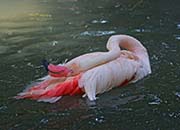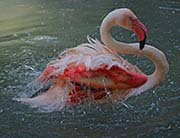Greater Flamingo - Phoenicopterus roseus
| Length | |
| Wingspan | |
| Weight | |
| Clutch Size | |
| Chicks at birth | |
| IUCN Conservation Status | |
Continents: |
The Greater Flamingo is the largest of the six species of Flamingos. They are found in Africa, India, Pakistan and southern Europe. Their pink plumage is a familiar sight at many zoos.
The color of their plumage is influence by their diet. In the wild, the crustaceans they eat have a pigment that gives them the pink plumage. In zoos, they are fed food contains the needed pigments to keep this recognizable color. The Greater Flamingo secondary flight feathers are black and their bill is pink with a black tip. Their legs and feet are pink.
Flamingos are social birds. They live in flocks of various sizes. Sometimes the flocks can number in the thousands. They also live long lives for birds and live between 20-30 years.
Diet: Flamingos have very long legs and they are able to search for food in deep water. Flamingos eat by using their feet to stir up mud and then sucking in this mud and water through their bill and out the sides. Briny plates in their mouth filter out small shrimp, seed, algae, microscopic organisms and mollusks.
Courtship: Flamingos perform elaborate group displays before, during and after breeding. Sometimes they perform one display together, other times they will perform a sequence of displays. Display include stretching their neck and pointing they bill upward and swaying they head back and forth. Another includes a group of flamingos marching together in synchronized steps. The displays are accompanied by loud growling and grunting sounds.
Nesting: Both parents build the mud nest by using their bills to move the mud to a height of about 12". The height is needed to keep the single egg laid dry and not too hot. Both parents incubate the egg and when it hatches, they both feed the chick crop milk that comes from the parents' upper digestive tract.
Habitat and Range: In the wild, Flamingos live in mudflats and shallow coastal lagoons with salt water.
Vocalization: During the breeding season they make loud growling and grunting sounds.
Plumage/Molt: No alternate plumage.
Migration: Flamingos don't normally migrate, but will if their habitat degrades. For example, if their lake freezes or there is a drought. When they do migrate, they tend to migrate at night and fly at high altitudes. When they fly, Flamingos need space to take off. They need to run far enough to generate the lift need to take off.
Tongue/feet: Pink feet and legs.
Bibliography:
- http://en.wikipedia.org The Free Encyclopedia, Accessed June 2012
- http://www.sandiegozoo.org/animalbytes/ San Diego Zoo, Accessed June 2012
- http://www.auduboninstitute.org/animals/ Audubon Nature Institue, Accessed June 2012
- http://www.zoo.org Woodland Park Zoo, Seattle, WA, Accessed June 2012
- http://violets-and-lace.com/archives/category/birds Growing to a Better Future, Accessed June 2012

